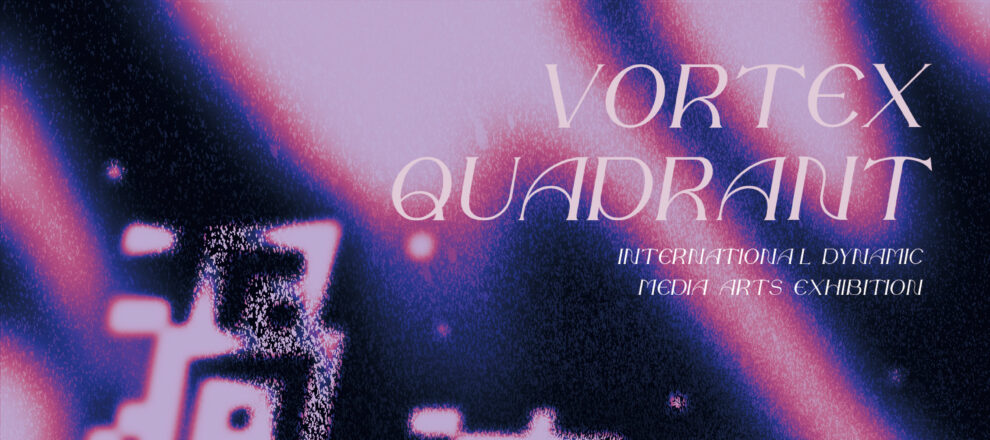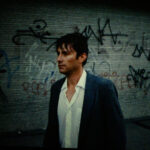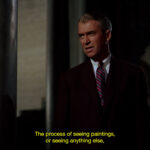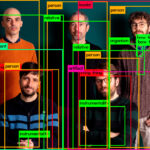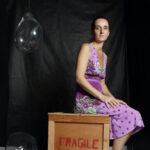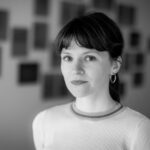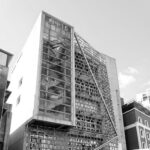This selection features eight works from the latest edition of the international moving image festival PROYECTOR, a platform that, while traditionally favoring installation, performative, and analog proposals, now stands out by focusing on pieces that explore the instability and multiplicity of «today.» These works offer a critical and poetic analysis of the social, political, and technological landscapes shaping contemporary experience, challenging preconceived notions of the domestic, the material, the symbolic, and the historical.
This is an invitation from Huang Derrick for a joint exhibition with several other Taiwanese artists.
Between Digital Weaves and Industrial Spaces
In Patterns Against Workers by Olena Newkryta, the invisible structures underlying digital technologies are unraveled, highlighting the connections between automation, labor exploitation, and human exhaustion. The work denounces the presumed immateriality of the digital, revealing its roots in complex historical and economic systems, and frames fatigue as a space of potential resistance.
In contrast, Semiotics of the Home, by Hsin-Yu Chen & Jessi Ali Lin presents construction machinery displaced into a domestic setting, transforming an intimate space into a theater of industrial performativity. By animating these tools to perform everyday tasks, the work subverts our notions of home, questioning the relationship between humanity, technology, and the environments we inhabit.
Landscapes Resonating with Memory
Marcela Cabutti, in El sonido de la piedra, explores the dialogue between geological time and human intervention. Through the sound and visual documentation of an ancient stone in Balcarce, Argentina, the work connects physical movement with the deep origins of territories. The vibrations of the rock act as a resonance of the past that interrogates the present, integrating history, nature, and the body into a unified rhythm.
In Brises, Enrique Ramírez revisits Chile’s recent history from a deeply personal perspective. In a single 10-minute take, a walker traverses the Palacio de La Moneda in Santiago, evoking the tensions and scars of the country’s dictatorial past. The work reflects on the right to look back, to occupy and reinterpret spaces of collective memory, underlining how the past shapes both individual and social bodies.
In Errant Gestures, Maya Schweizer compiles intentional and unintentional movements in sound and image, presenting a cinematic collage that explores everyday gestures as a bridge between conscious action and the unconscious. Through interwoven fragments, the work includes the voice of Vilém Flusser reflecting on patterns of movement and their links to different states of consciousness. Schweizer invites us to contemplate those fleeting moments that connect our perception with the environment, blurring the boundaries between the tangible and the intangible in everyday experience.
Identity, Representation, and Forces of Change
In The Bride, Clara Abi Nader addresses the social pressures and meanings attributed to marriage within the context of social media. Through a visual exploration of the roles expected of women in marriage and their public representation, the work critiques the showcases of perfection we construct in our digital lives and the choices that defy societal norms.
In The Same Track, Thenjiwe Niki Nkosi interrogates the colonial legacy inherent in the Commonwealth Games, symbolically connecting the inertia of imperialism to contemporary social structures. Presented in a multimedia format, the work questions the narratives upholding these practices, reflecting on what forces must act to transform the remnants of an imperial past into a more equitable present.
In The Vertigo of the Ways of Seeing, the collective, ESTAMPA uses John Berger’s Ways of Seeing as a starting point to meditate on perception and the questioning of images. This work reflects on contemporary visual construction, the gaze, and the interpretations that shape our relationship with the world.
A Shared Thread
Although diverse in form and content, these eight works share a concern for unveiling the invisible frameworks that shape contemporary reality, whether through economic exploitation systems, cultural symbols, geological structures, or social roles. In this sense, PROYECTOR reaffirms its role as a meeting point to reflect on the time we inhabit and the ways in which moving images can capture, transform, and resist the forces that permeate us.

